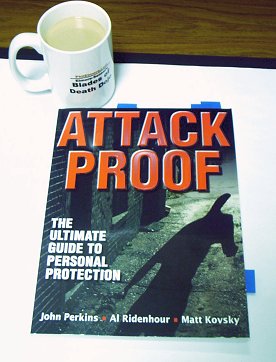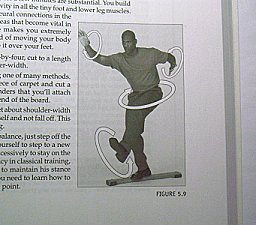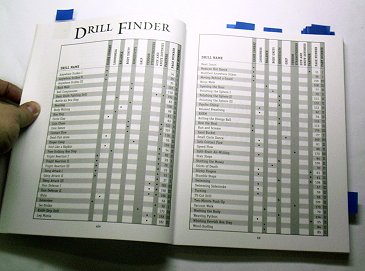its paid sponsors, whose products you need!
| Home |
| Intro |
| Current Issue |
|
Mailing List |
| Store |
| Strength |
| Subscriber Content |
| ARCHIVES
|
| Martialism |
| Pacifism |
| Q & A |
| Cunning-Hammery |
| Advertise With Us |
| Submit An Article |
| Staff |
| Discussion Forum |
| Links |
“Stay ‘unreasonable.’ If you
don’t like the solutions [available to you], come up with your
own.”
Dan Webre
The Martialist does not
constitute legal advice. It is for ENTERTAINMENT
PURPOSES ONLY.
Copyright © 2003-2004 Phil Elmore, all rights
reserved.
Attack Proof
A Book Review by Phil Elmore
John Perkins’
Attack Proof is a
remarkably good book that didn’t really teach me anything.
Before I get myself into trouble, let me explain. I
actively study two martial arts:
Wing Chun and
Shanliang Li. The former is an
infighting style characterized by centerline awareness, touch-go reflexes,
efficient striking, and the refusal to fight
force with force. The latter is a highly meditative art that relies
primarily on open-hand strikes and, despite its somewhat mystical outlook, is
also viciously practical in use against an opponent. Both arts contain
components of military combatives. I strive
to integrate these with the application of both.

The resulting combat style is a flowing, ruthless, and fast
expression of sound martial principles one that is sensitive to the
“energy” of an opponent’s movements and attacks and that permits me to work
around those attacks to quickly (or preemptively) counter them. It is a
style that relies on structure, not muscle alone, for the delivery of power.
It is also characterized by good balance and a flexible, adaptable approach
that relies on principles rather than rote techniques.
If this sounds a lot like the contents of Attack Proof,
the book made the same impression on you that it did on me. When I first
purchased the text, I did so specifically because (at first glance) its
contents seemed curiously similar to the ideas my Shanliang Li teacher was
trying to impart to me. As I read the text, I spent a lot of time
nodding approvingly. Very little the book contained was material I had
not seen before, but this was the first book I’d found that distilled most of
what I was learning in a single source.
This is not to say that the book is perfect. Too much
time is spent telling the reader how very unique and different is Attack Proof, some of the content is a bit melodramatic in tone, and some of the
street-smart advice offered in the Awareness chapter is of debatable merit or
relatively unoriginal. Perkins and his co-authors also advocate looking
“terrified” to put an assailant at ease, which one could argue only encourages
the attacker.
One of Attack Proof‘s tenets is avoiding
confrontation at all costs. The “pacifism of the warrior” is a concept I
cannot accept, for I believe there are some principles and some people for
which and for whom one must stand up in the face of disrespect, intimidation,
and non-physical offense. There’s no arguing that avoiding physical
confrontation is the path of least resistance where survival is concerned, but
I don’t believe in survival at any cost. Some things are worth
the risk of injury or death. This is, however, simply my personal
conviction.
Leafing through Attack Proof in the book store might
lead the reader to conclude that this is a mystical, Tai Chi-style text that
relies heavily on the energy-manipulation techniques of esoteric and internal
martial arts. This is primarily a misconception prompted by the numerous
photos illustrating what turn out to be drills, not fighting techniques.

While Perkins and his partners do spend some time discussing
chi, the fighting principles they advocate do not rely on “energy projection.”
Just as I view chi as a metaphor for the mechanics of body movement that I
learn in Wing Chun, the “energy” discussed in Attack Proof can be taken
as shorthand for the methods used in yielding to, redirecting, and countering
incoming force.
There are so many drills in Attack Proof that the
authors have included a two-page reference grid for locating them. The
level of participation the reader experiences is thus a matter of choice, as
each major topic is accompanied by suggestions for practice and attribute
development. Also sprinkled throughout the book are anecdotes from John
Perkins’ law enforcement career, margin notes emphasizing key points, and
helpful lists of tips for “Preventing Common Mistakes.” This is good
instructional design and enhances the clean, well-thought-out presentation of
the material.

After an introduction summarizing the book’s contents,
Perkins and his co-authors devote a chapter to Awareness (including the
street-smart guidelines to which I referred earlier, such as ATM safety rules
and strategies for avoiding pickpockets and muggers). The reader is
urged to develop “hostile awareness” in preparation for self-defense decision
making. Perkins also recommends the usual awareness texts: Gavin DeBecker’s The Gift of Fear and Sanford Strong’s Strong on Defense.
“Basic Strikes and Strategies” are covered in Chapter Two,
including a discussion of the “interview” phase of an imminent attack.
The “Jack Benny” stance, a common non-aggressive self-defense posture, is
illustrated and discussed. We are then introduced to basic combatives
strikes, including the chin jab, chops, spears, ridge hands, claws, rips,
tears, pinches, bites, head butts, and elbow strikes.

“Jack Benny” stance shown from the front.
The paragraph on head butts does not properly warn the
reader of the dangers of the technique. I would question the overall
conceptual efficiency of “pinches,” as well, but on the whole this is solid
information. The groin strike as magical off-button is debunked, low
knee strikes are mentioned, and low, non-telegraphic kicks are included in the
section. Closed-fist strikes are also mentioned, primarily to list their
dangers and shortcomings.
The need to deliver multiple strikes in rapid succession is
properly emphasized. “Guided Chaos” is used as a catch-all term for the
aggressive, flowing application of strikes (it is a portion of the title of
Part Two of the book, “Guided Chaos and Mind Principles”) used to overwhelm an
opponent.
In Chapter Three, “Looseness,” Perkins and company
explain how to remain relaxed, yield to a strike while preemptively or
reactively counterattacking, and “pocket” the body to avoid or absorb a blow.
The ensuing discussion is very similar to the application of touch reflexes
developed through Wing Chun’s chi sao practice
refusing to fight force with force and
flowing with or “running” around an attack to strike the attacker.
Chapter Four’s explanation of “body unity” veers into a
discussion of chi that will turn off advocates of pragmatic combatives, but it
is relatively brief. Fortunately, it also includes an anecdote from John
Perkins largely dismissing the “no-touch knockout” and “energy projection”
claims of some deluded martial artists. “…[A]s far as projecting a
shield of energy around the body,” Perkins writes, “…ask the claimant if he
would allow you to poke him in the eye. See if he can bounce your finger
off with pure energy.”
The chapters on balance and sensitivity that follow
reinforce the need to be rooted and the benefits of touch reflexes in
combat. Dropping the body as a source of power the key to both the combatives drop step and the
one-inch punch is mentioned. Different
types of “energy” are detailed. It is helpful to remember that this is
not a write-up of “the Force,” but an explanation of mechanics and kinetic
energy. The inclusion of this subject is not surprising given the link
to human kinetics
listed on the book’s copyright page.
In describing how to apply Attack Proof principles to
self-defense, the authors explain the characteristics of a good (and
“formless”) fighting stance, emphasize the need to
take your opponent’s space (the “forward drive” of combatives), and
examine “the body as a weapon.” It’s worth noting that Perkins advocates
striking quickly rather than trying to block a strike first, explaining that
the counter will happen incidentally. (Don’t confuse this with the
vulnerable striking-without-covering mentality of, say,
Hikuta, nor with the semantics of
SCARS though it is compatible with the simultaneous
blocking and striking of other arts.)
Chapter Eight explains “economy of movement.” This is
welcome material, for all of us should learn to move with purpose while
flowing in our application. A chapter on grabs and locks, with the
appropriate admonition to avoid groundfighting whenever possible, follows.
Counters to basic grabs and strategies for resisting a grappler are briefly
discussed as we move into Chapter Ten, “Ground Fighting and Weapon Defense.”
The basic weapons counters shown are sound, though the
paragraphs on multiple opponents might better have been expanded and moved to
a separate chapter, There are brief sections on sticks and canes, knife
defense, and keep-it-simple offense with a blade. Defending against
firearms at close ranged is also discussed.
The book closes with a brief review of “guided chaos,”
suggestions for developing a training regimen, and a glossary of terms.
One of the nicer features of the book is that it includes a topic index
something on which too many publishers skimp these days.
“‘Attacking the attacker’ is guided chaos in a nutshell,”
the authors write. “Using stealth energy, if you can slide through your
opponent’s attack while dropping, multihitting, yielding, and moving behind a
guard, your defense is actually an attack.”
While I am obviously pleased overall with the material
presented in Attack Proof, the name deserves comment. No
one, no matter how well-trained, no matter in what the individual studies, is
attack proof. The title is therefore disingenuous and smacks of
the type of marketing I hate most in the martial arts industry.
Once you get past this and the complaints I listed
earlier, you’ve got a surprisingly good book that distills many of the
principles and techniques I would advocate (and that I use and train myself).
No book is perfect and no single text can be all things to all people.
This book, though, gets quite a
bit right in a single volume.
